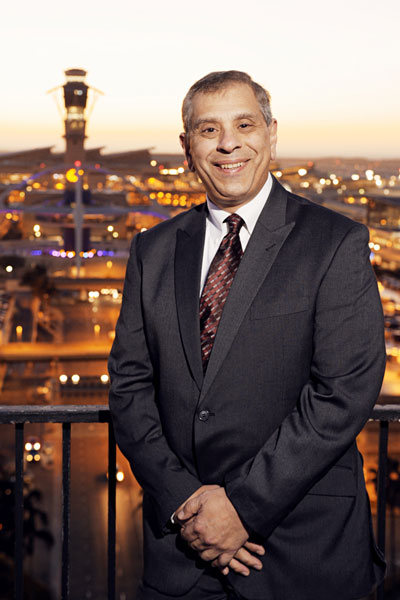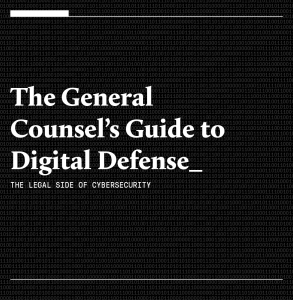
Los Angeles World Airports
Los Angeles may be known as the City of Angels, but to Dominic Nessi it’s a city of airports. As deputy director and chief information officer of Los Angeles World Airports (LAWA), he oversees all non-airline affiliated digital functions at Los Angeles International Airport (the second busiest airport in the United States and fifth busiest in the world), Van Nuys Airport (one of the world’s busiest general aviation facilities) and LA/Ontario International Airport in San Bernadino county.
His responsibilities cover everything from phone and paging systems, passenger-facing websites, email, desktop computer networks, financial and HR systems, video security systems, radio communications, facilities management, and the airport operations center.
“Unlike most other airports, everything at LAX is now very centralized, so, if it’s digital, I handle it,” Nessi says. “Because my title is CIO, if I work late at night, I even get questions about what terminal a particular carrier flies out of.”
Though he grew up next to Midway Airport in Chicago and fostered a fascination with travel and airports his whole life, Nessi’s career path was not that of a typical CIO for a major airport. Prior to his time at LAWA, Nessi taught at Metropolitan State University of Denver, acted as deputy assistant secretary for Native American programs at the US Department of Housing and Urban Development, and was chief information officer for the US Department of the Interior–Indian Affairs and the National Park Service.
“Maintaining the diversity of the staff and hiring and promoting based on merit and ability is second-nature to me. Even though I don’t take credit for how diverse my employees are, I try to accommodate their career goals.”
When he learned of the search to fill his current position, Nessi began conducting extensive research: attending aviation conferences and interviewing experts to find out everything he could about LAWA, its challenges, and the products and solutions available for addressing them. Although he assumed he was a long-shot candidate, at his second-to-last interview he brought an agenda of what his goals and priorities would be for his first 100 days on the job.
The Culture Of Collaboration
Aside from his familiarity with many of LAWA’s management and operational systems, which he used while with the National Park Service, Nessi believes that there was another particular element that helped him get hired.
“I can say as a retired federal employee, one thing the government does very well is prepare you not only to manage a diverse list of priorities, but also a diverse staff,” he says. “So maintaining the diversity of the staff as it existed when I arrived and hiring and promoting based on merit and ability is second-nature to me. Even though I don’t take credit for how diverse my employees are, I am comfortable saying I try to accommodate their career goals whenever I am able.”
Members of Nessi’s team reiterate the culture of support and collaboration among colleagues and departments, both within IT and throughout the airport. The IT staff differs from the typical “white male-dominated IT shop,” Nessi explains, which he sees as a secondary benefit of hiring an incredibly talented team.
Powered by Collaboration
Sync spoke to members of Dominic Nessi’s diverse and talented staff to find out what makes them a successful team.
What factors do you feel make your IT team productive and successful as a group?
Micaela LeBlanc, Division Director: Communication, ability to provide training to staff, putting the right people with the right skill sets in the right position, and having industry standard policies, procedures, and practices make our IT organization one of the best in the world.
Florinda Carlos, Information Systems Manager: Every employee is aware that they’re accountable for their actions and decisions. Also important is the establishment of trust relationships that lead to better sharing of knowledge and understanding.
How do you think that the diversity of your team contributes to its success?
Anson Fong, Office of Information Security: I don’t think it really matters; it’s the attitude, the team-player atmosphere. I know a lot of hackers who are really talented and knowledgeable, but they can’t work in a team—they can only work with themselves. In my team, my people have different skills and backgrounds, but it doesn’t matter because as soon as we’re in the same group we share everything with each other.
Carlos: A diverse workforce creates more opportunities to understand and satisfy the needs of a diverse community of customers. Improved performance and greater innovation arise through harnessing the creativity of a group of people with different ways of looking at things cooperatively.
LeBlanc: Hiring based on skills and experience has contributed to our success. We give everyone who feels they can do a job an opportunity to demonstrate their capability. Those who produce the results needed usually are very successful, no matter what their cultural or other type background entails.
As part of a successful and diverse IT team, how do you view the hurdle of increasing diversity across the IT industry?
Carlos: Continuous improvement and constant training are needed. Other leaders, organizations, and companies can bring broader groups of backgrounds and perspectives into the industry if the organization will foster recruiting the right person for the job, regardless of their cultural background.
LeBlanc: Mentoring is important. Many skills in this industry don’t come from a textbook. Building a technical knowledge base in certain areas is important, but knowing how to manage stakeholders (at all levels of an organization), contractors, projects, budgets, and schedules are critical as well. A mentor or example on how to manage through all these items certainly helps. Additionally, learning to communicate in what I call “non-IT” language is important, as most of the decision makers for IT initiatives are not IT savvy.
What’s a project that you’re particularly proud of that required team coordination, and how did you contribute to it?
Carlos: Introducing HP Service Manager as the new IT Service Desk tracking system. My group was responsible for designing, building, and maintaining the system. In addition, we trained over 1,600 users on how to use the system in creating and updating work orders.
Fong: We deal with security-incident response every day. There’s always hacking going on, so we need to talk to every department here so we can make sure that they’re aware of the damage and how to prevent it. Working for an airport, we’re doing cybersecurity, but it’s not only limited to network security; it also covers physical security.
For example, recently somebody was operating a drone near the airport; inside the drone there’s a frequency jammer. That is considered physical, but it impacted our network and the cybersecurity here.
I work with a lot of police and try to educate and share information with them. In turn they’ve been training us on how to learn more about how physical security works, how to monitor it.
He also brought a very open, transparent, and communicative style to his new job. When he started, he met with each employee and gathered input to develop a list of their top goals and priorities.
“Everyone wants to be heard, appreciated, and part of a winning team, so I told them that if these were the things that were important to them in order to be one of the best facilities in the world, they would be important to me, too,” he recalls.
Nessi has continued to maintain an inclusive environment and to offer ongoing training and advancement opportunities. In 2015, LAWA’s Information Management and Technology Group was selected by Computerworld as one of the 100 Best Places to Work in IT, which Nessi says is due entirely to his team. He recalls a particular project, installing 1,400 CCTV cameras and creating a video management and storage system, for which the team won awards. Aura Moore, the deputy CIO, led the project, then turned it over to another woman to finish it. “Everybody on the team was from a different country,” Nessi says. “Whether or not that was why [it succeeded], I don’t know, but the woman who finished it personally won awards for that project.”
Another project that Nessi cites when thinking about his team’s strengths is the creation of a communications center, the ARCC. The IT team needed to work closely with the construction team, and also ensure that the center could meet the airport’s complex technology requirements. “It was truly a major accomplishment in that we were combining a great number of technology elements into one central site at one time,” Nessi says. “We were not only working on tech, but on the people in the operations center who would be using the tech to ensure it would work for them. It was a tremendous accomplishment for us.”
System Upgrades
Some of LAWA’s notable improvements include:
• Building a centralized airport operations center
• Establishing an emergency messaging system
• Installing 3,000 digital, wireless security cameras
• Implementing a police trunked radio system
• Launching MAXIMO facilities-management software
• Upgrading vehicle security
• Strengthening physical access control devices
• Instituting a document-management system
It took a lot of work to get to that sense of accomplishment. Nessi inherited a daunting number of technological hurdles when he became CIO. These included administrators and managers who were disbursed throughout the various facilities, and, perhaps most alarming, a security infrastructure that was severely outdated. Analog cameras, for example, sent images to 320 video recorders that required constant monitoring by security officers so they could manually archive and replace tapes when they were full.
Implementing IT Systems For Airports
At an airport, IT security comprises more than firewalls; Nessi’s department has had to work closely with the physical security staff and the airport’s police force to prevent perimeter intrusions and thwart rogue drones hovering too close to the runways and interfering with airport communication systems.
“We’re a service organization, and in this particular project, we are serving our police department,” Nessi says. “This won’t work if we don’t have a good relationship with the police department, which we do.”
Rather than being overwhelmed by so many pending issues, Nessi describes it as a “fun challenge” to be able to create new systems from scratch. He also made the decision to tackle them all at once instead of taking a more traditional multiphase approach.
One of the most recent initiatives has been the mobile Terminal Inspection Program System. Using handheld devices, personnel can inspect 900 different critical assets, score and color-code their condition and performance, and pinpoint their locations using a geographic information system.
With a history of looking for comprehensive solutions to seemingly insurmountable problems, Nessi says that his focus remains on balancing all the different demands of serving an organization with a wide array of IT needs.
“The biggest challenge is keeping so many different moving pieces up and running 24/7,” he says. “The only way to do that is to view the entire scope of operations as a holistic environment with redundancies, flexibility, agility, and diversity so you can respond appropriately. Plus, I have the best staff in the world backing me up.”
Learn more about cybersecurity prevention and response in the legal and IT fields with a white paper from Sync titled The General Counsel’s Guide to Digital Defense. The Legal Side of Cybersecurity. Click below to download this complimentary industry insight report.

